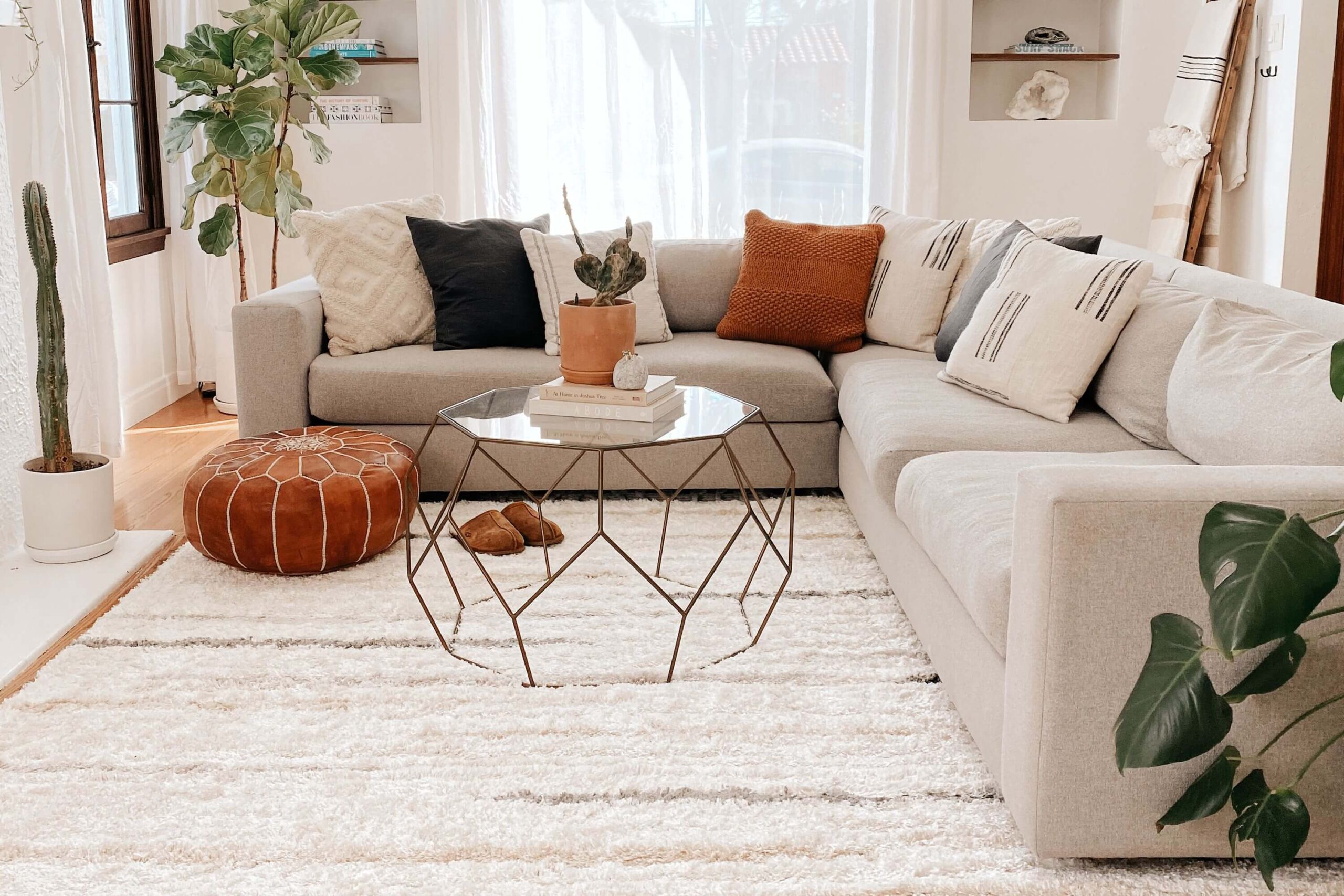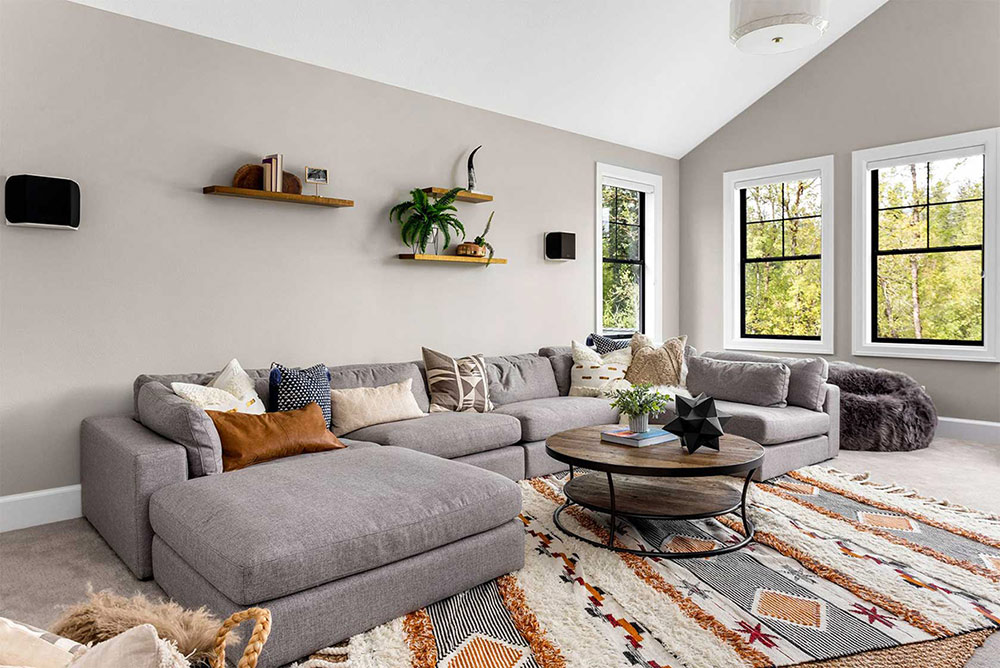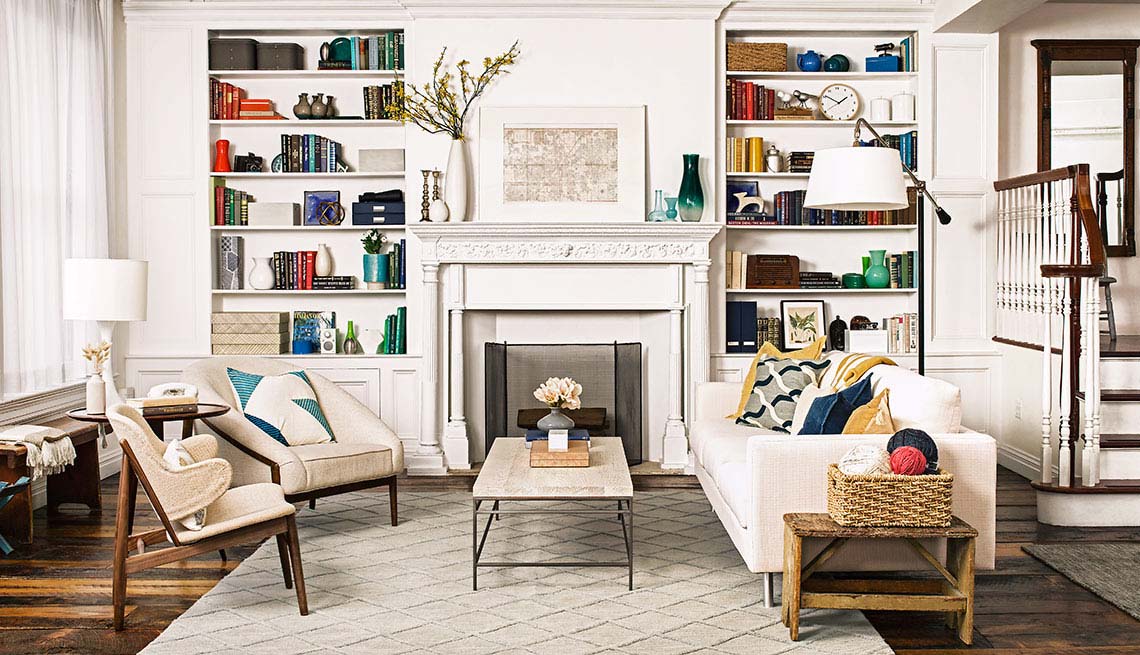1. Tips for Arranging Furniture in a Living Room
When it comes to designing a living room, one of the most important things to consider is the placement of furniture. Not only does it affect the flow and functionality of the space, but it also has a big impact on the overall aesthetic. Here are some tips to help you arrange your furniture in the most optimal way:
- Start with the focal point: The focal point is the main feature of the room that draws the eye. It could be a fireplace, a large window, or a TV. Arrange your furniture around this focal point to create a cohesive and visually appealing layout.
- Create a conversation area: Arrange your sofa and chairs in a way that encourages conversation and interaction. This could be facing each other or at a slight angle to create a cozy and intimate atmosphere.
- Consider the flow of traffic: Make sure there is enough space for people to move around the room comfortably. Avoid blocking doorways or walkways with large pieces of furniture.
- Mix and match furniture styles: Don't be afraid to mix and match different styles of furniture for a more eclectic and interesting look. Just make sure they still complement each other in terms of color and scale.
- Use rugs to define areas: Rugs are a great way to define different areas within a living room, especially in open concept spaces. Use a large rug to anchor the seating area and smaller rugs to define other areas like a reading nook or a coffee table.
2. How to Make a Small Living Room Look Bigger
Having a small living room doesn't mean it has to feel cramped and uncomfortable. With the right design choices, you can make your small space look and feel bigger. Here are some tips to help you achieve this:
- Use light colors: Light colors reflect more light and create an illusion of space. Stick to light shades of white, beige, or pastels for your walls, furniture, and decor.
- Incorporate mirrors: Mirrors not only add a decorative element to a room, but they also reflect light and make a space appear larger. Hang a large mirror on one of the walls or create a gallery wall with different sized mirrors for a statement piece.
- Choose multi-functional furniture: When working with a small living room, every inch of space is valuable. Opt for furniture pieces that serve multiple purposes, such as a coffee table with storage or a sofa that can be converted into a bed.
- Keep it clutter-free: Clutter can make a small space feel even smaller. Keep your living room organized and clutter-free by using storage solutions like baskets, shelves, and wall-mounted cabinets.
- Let in natural light: Natural light can make a room feel more spacious and airy. Avoid blocking windows with heavy curtains or furniture, and instead, opt for sheer curtains or blinds that let in natural light.
3. Creative Storage Solutions for Living Rooms
Living rooms are often a hub of activity and can quickly become cluttered with various items like books, magazines, remote controls, and toys. To keep your living room organized and clutter-free, here are some creative storage solutions:
- Utilize vertical space: Install shelves or use a ladder bookshelf to make use of vertical space. This not only provides extra storage but also adds a decorative element to the room.
- Use hidden storage: Choose furniture pieces with hidden storage, such as ottomans with storage space inside or sofas with built-in storage compartments. This allows you to keep items out of sight but still within reach.
- Hang floating shelves: Floating shelves are a great way to add storage without taking up precious floor space. Use them to display books, plants, or decorative items.
- Invest in a storage ottoman: A storage ottoman is a versatile piece of furniture that can be used as extra seating, a coffee table, and storage. You can store blankets, pillows, or even board games inside.
- Get creative with baskets: Baskets are not only functional but also add texture and warmth to a room. Use them to store items like throw blankets, toys, or magazines.
4. Choosing the Right Color Scheme for Your Living Room
The color scheme of your living room sets the mood and tone of the space. It's important to choose a color scheme that not only reflects your personal style but also creates a cohesive and inviting atmosphere. Here are some tips for choosing the right color scheme:
- Consider the function of the room: Think about how you want to use your living room. Is it a space for relaxation and unwinding, or is it a more formal and elegant space? This will help guide your color choices.
- Use a color wheel: A color wheel can be a helpful tool in choosing a cohesive color scheme. Complementary colors (colors opposite each other on the wheel) create a vibrant and bold look, while analogous colors (colors next to each other on the wheel) create a more harmonious and calming feel.
- Take inspiration from existing elements: If you have a piece of furniture or artwork that you love, use it as a starting point for your color scheme. Pull out a few key colors from this inspiration piece and use them throughout the room.
- Use neutral colors as a base: Neutral colors like white, beige, and gray make great base colors and allow you to add pops of color with accessories like pillows, rugs, and artwork.
- Consider the lighting in the room: The lighting in a room can greatly affect how colors appear. If your living room has a lot of natural light, you can be more bold with your color choices. If it's a dimly lit space, stick to lighter colors to avoid making the room feel smaller.
5. Simple Ways to Update Your Living Room on a Budget
Updating your living room doesn't have to break the bank. With a little creativity and some smart shopping, you can give your living room a refresh without spending a lot of money. Here are some simple ways to update your living room on a budget:
- Rearrange your furniture: Sometimes all it takes is a new furniture arrangement to give a room a whole new look. Experiment with different layouts and see what works best for your space.
- Add a pop of color: Adding a new color to your living room can instantly liven up the space. You can do this with a colorful rug, throw pillows, or a piece of artwork.
- Incorporate DIY projects: Get creative and make some DIY decor pieces for your living room. You can make your own wall art, throw pillow covers, or even a coffee table with some simple materials.
- Shop second-hand: You can find great deals on furniture and decor at thrift stores, flea markets, and online marketplaces. Give these pieces a fresh coat of paint or reupholster them to match your style.
- Use what you already have: Instead of buying new items, shop your own home for things that can be repurposed or refreshed. You can use old books as decor, turn a scarf into a throw pillow cover, or repaint an old piece of furniture.
6. Tips for Creating a Cozy Living Room
A living room should be a place of comfort and relaxation. To create a cozy and inviting space, here are some tips to keep in mind:
- Use warm and inviting colors: Colors like warm shades of brown, red, and orange create a cozy and welcoming atmosphere. You can incorporate these colors through your furniture, decor, or accent wall.
- Layer textures: Adding different textures to a room, such as a chunky knit throw, a soft rug, or a velvet pillow, can make it feel more cozy and inviting. Mix and match different textures for a more interesting look.
- Incorporate soft lighting: Harsh lighting can make a room feel less cozy. Use warm and soft lighting, such as table lamps or string lights, to create a cozy ambiance.
- Use natural elements: Bringing elements from nature, like plants, wood, or stones, can add a sense of warmth and coziness to a room. You can incorporate these elements through decor pieces or even a small indoor garden.
- Add personal touches: Decorating with items that have sentimental value, such as family photos or handmade decor, can make a space feel more personal and cozy.
7. Maximizing Natural Light in Your Living Room
Natural light not only makes a room feel more spacious but also has a positive effect on our mood and well-being. Here are some tips for maximizing natural light in your living room:
- Avoid heavy window treatments: Heavy curtains or blinds can block natural light from entering the room. Instead, opt for sheer curtains or blinds that allow light to filter through.
- Use mirrors: As mentioned earlier, mirrors can reflect light and make a room appear larger. Hang a mirror on a wall opposite a window to reflect the natural light into the room.
- Keep windows clean: Dirty windows can greatly affect how much natural light enters a room. Make sure to regularly clean your windows to allow as much light as possible.
- Use light-colored furniture and decor: Light-colored furniture and decor, such as white or light wood, can reflect light and make a room feel brighter. This is especially helpful in smaller living rooms.
- Use light-reflecting materials: Materials like glass, chrome, and metallics can reflect light and make a room feel brighter. Incorporate these materials through furniture, decor, or even light fixtures.
8. Incorporating Plants into Your Living Room Decor
Plants not only add a decorative element to a room but also have numerous health benefits, such as improving air quality and reducing stress. Here are some tips for incorporating plants into your living room decor:
- Choose low-maintenance plants: If you're new to plant care, opt for low-maintenance plants like succulents, snake plants, or pothos. These plants require minimal watering and can thrive in various lighting conditions.
- Use different types of plants: Mix and match different types of plants, such as hanging plants, tall plants, and small plants, to add dimension and interest to your living room.
- Use planters as decor pieces: Planters come in various sizes, shapes, and materials, making them great decorative pieces for a living room. You can choose planters that complement your existing decor or make a statement with bold and colorful ones.
- Create a green corner: If you have a corner in your living room that doesn't get much use, turn it into a green corner by placing a variety of plants together. This not only adds interest to the room but also creates a relaxing and natural ambiance.
- Incorporate plants into your shelf styling: If you have shelves in your living room, use plants to add a pop of color and life to them. Mix them in with books and decor pieces for a more cohesive look.
9. How to Choose the Perfect Rug for Your Living Room
Rugs not only add warmth and texture to a room but also help define different areas within a living room. Here are some tips for choosing the perfect rug for your living room:
- Consider the size: The size of the rug is crucial for creating a cohesive and balanced look. Make sure to measure your living room and choose a rug that fits the space appropriately.
- Choose the right material: Rugs come in various materials, each with its own pros and cons. For high-traffic areas, choose a durable and stain-resistant material like wool or nylon. For a more cozy and plush feel, opt for materials like shag or faux fur.
- Think about the color and pattern: Rugs can add a pop of color and pattern to a room, so choose one that complements your existing color scheme and decor. If your living room has a lot of patterns, opt for a solid-colored rug, and vice versa.
- Consider the shape: While rectangular rugs are the most common choice, consider other shapes like round, oval, or square for a more unique and interesting look.
- Layer rugs: If you have a smaller rug that you love but isn't the right size for your living room, consider layering it on top of a larger rug. This not only adds visual interest but also allows you to incorporate different textures and patterns.
10. Tips for Decluttering and Organizing Your Living Room
A cluttered and disorganized living room can make it difficult to relax and enjoy the space. Here are some tips for decluttering and organizing your living room:
- Start with a clean slate: Before you start organizing, take everything out of the living room and give it a good clean. This will help you see the space more clearly and make it easier to declutter.
Tips for Creating a Welcoming Living Room

Make Use of Natural Light
 One of the key elements in designing a comfortable and inviting living room is to
utilize natural light
. Not only does it create a warm and welcoming atmosphere, but it also helps to save on energy costs.
Maximize natural light
by keeping windows unobstructed and using light-colored curtains that allow sunlight to filter through. Additionally, strategically placing mirrors in the room can also help to reflect and amplify natural light.
One of the key elements in designing a comfortable and inviting living room is to
utilize natural light
. Not only does it create a warm and welcoming atmosphere, but it also helps to save on energy costs.
Maximize natural light
by keeping windows unobstructed and using light-colored curtains that allow sunlight to filter through. Additionally, strategically placing mirrors in the room can also help to reflect and amplify natural light.
Add Greenery
 Another way to bring life and warmth into your living room is to
incorporate some greenery
. Plants not only add a pop of color and texture to the space, but they also purify the air and have been proven to reduce stress and improve mood. Choose low-maintenance plants such as succulents or snake plants that can thrive in low-light conditions.
Another way to bring life and warmth into your living room is to
incorporate some greenery
. Plants not only add a pop of color and texture to the space, but they also purify the air and have been proven to reduce stress and improve mood. Choose low-maintenance plants such as succulents or snake plants that can thrive in low-light conditions.
Invest in Comfortable Seating
 The living room is often the central gathering place in a home, so it's important to have
comfortable and inviting seating
. Consider investing in a quality sofa or sectional that fits the size and layout of your living room. Add
cozy accent pillows
and throws for extra comfort and style. Don't forget to also include enough seating for guests by incorporating chairs or ottomans.
The living room is often the central gathering place in a home, so it's important to have
comfortable and inviting seating
. Consider investing in a quality sofa or sectional that fits the size and layout of your living room. Add
cozy accent pillows
and throws for extra comfort and style. Don't forget to also include enough seating for guests by incorporating chairs or ottomans.
Play with Textures and Patterns
 Adding
textures and patterns
to your living room can create visual interest and make the space feel more cozy and inviting. Incorporate a mix of textures such as a soft rug, a chunky knit throw, and smooth leather accent pieces. Use patterns in your decor, such as a bold printed rug or patterned throw pillows, to add depth and personality to the room.
Adding
textures and patterns
to your living room can create visual interest and make the space feel more cozy and inviting. Incorporate a mix of textures such as a soft rug, a chunky knit throw, and smooth leather accent pieces. Use patterns in your decor, such as a bold printed rug or patterned throw pillows, to add depth and personality to the room.
Keep Clutter at Bay
/beginners-guide-decorating-living-rooms-2213483-01-dc1147fbe923412da3fe215f7583e66a.jpg) A cluttered living room can quickly make the space feel chaotic and unwelcoming.
Declutter and organize
your living room by finding proper storage solutions for items such as books, remotes, and other miscellaneous items. Consider incorporating hidden storage options, such as a storage ottoman or a coffee table with built-in drawers, to keep the space looking neat and tidy.
A cluttered living room can quickly make the space feel chaotic and unwelcoming.
Declutter and organize
your living room by finding proper storage solutions for items such as books, remotes, and other miscellaneous items. Consider incorporating hidden storage options, such as a storage ottoman or a coffee table with built-in drawers, to keep the space looking neat and tidy.
Incorporating these tips into your living room design can create a warm and inviting space for both you and your guests to enjoy. Remember to experiment with different elements and make it your own personal style. With these tips, you can create a welcoming and comfortable living room that you'll love spending time in.






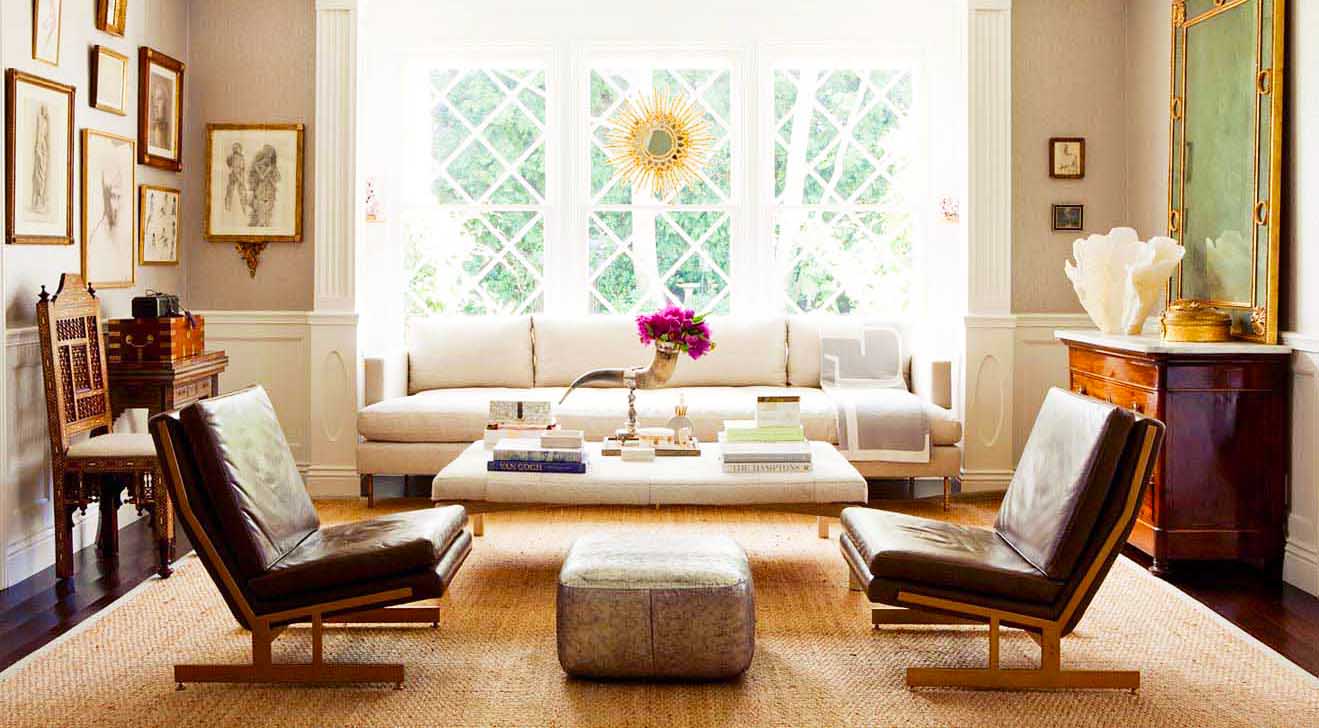











:max_bytes(150000):strip_icc()/make-a-small-room-look-bigger-1976069-hero-7b4bc2bb37994004bae71301c5fc88e4.jpg)













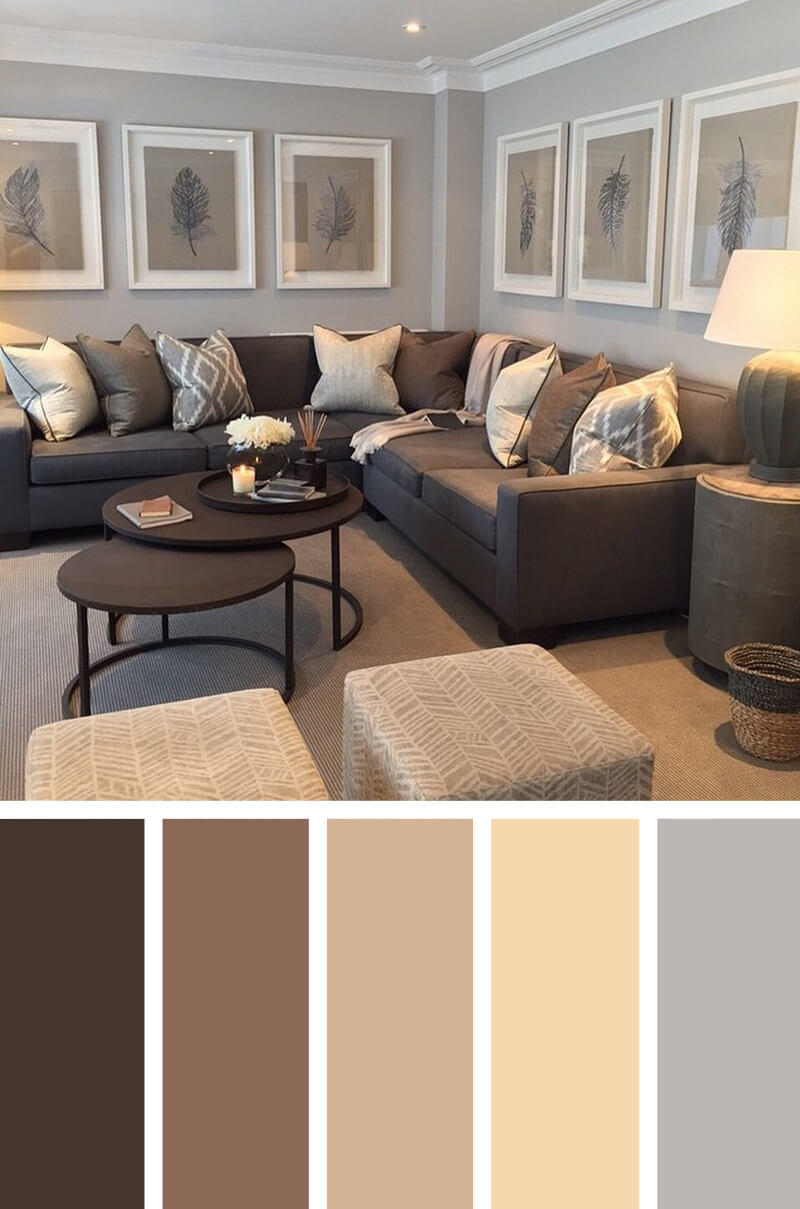










:max_bytes(150000):strip_icc()/showcase-home-interior-looks-inviting--487916813-5accd093fa6bcc00361bb970.jpg)






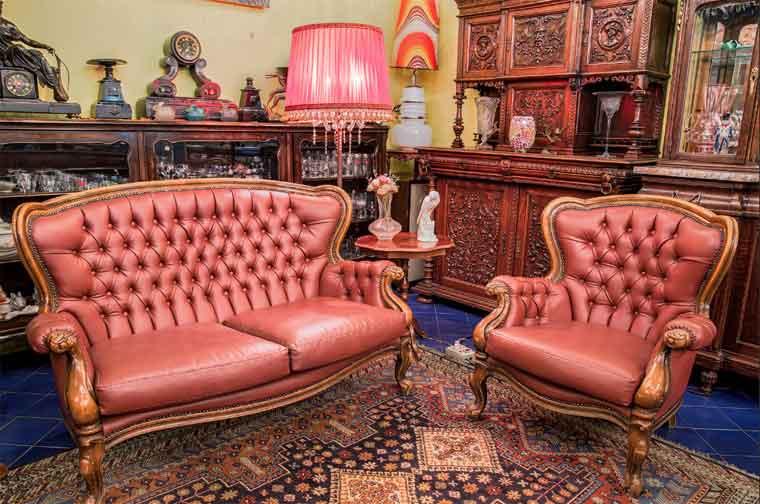
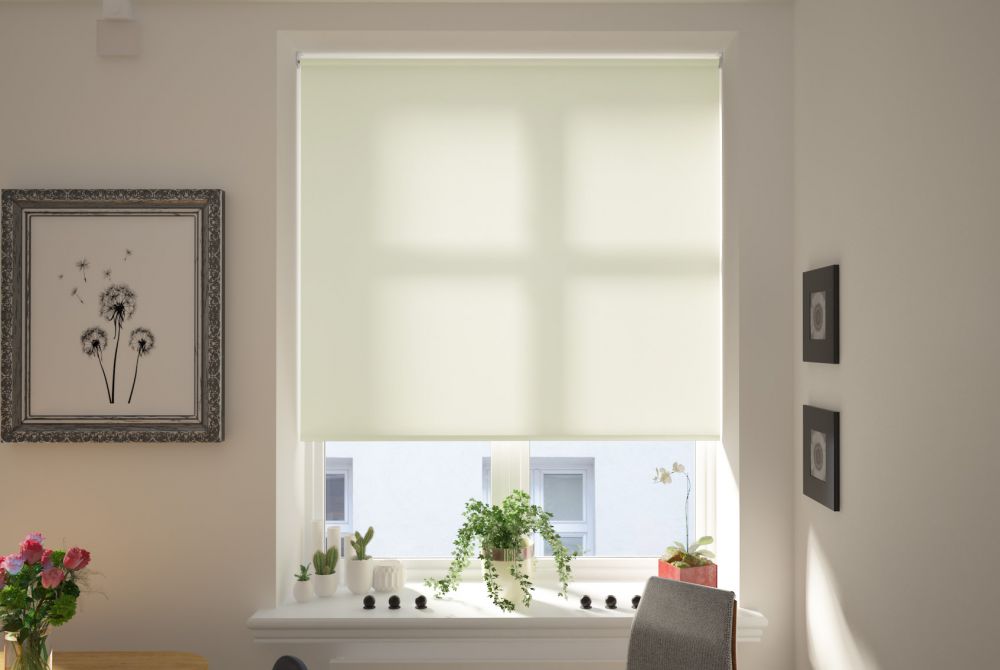


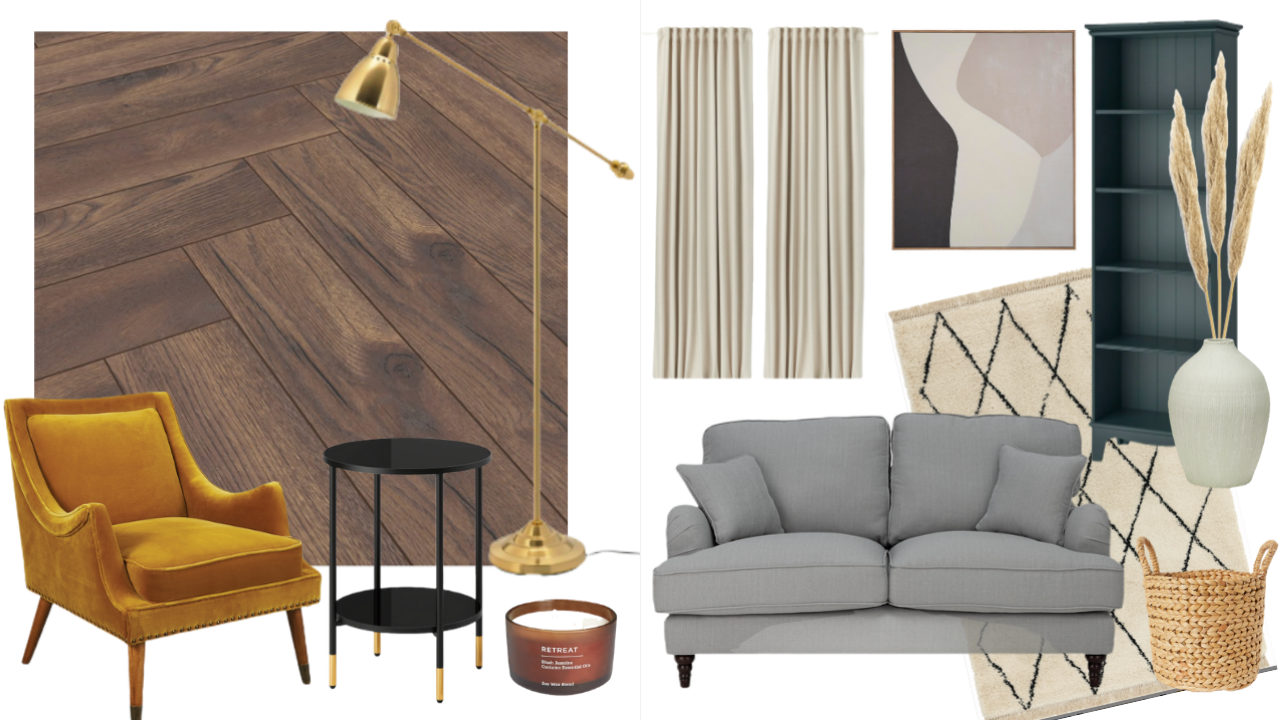







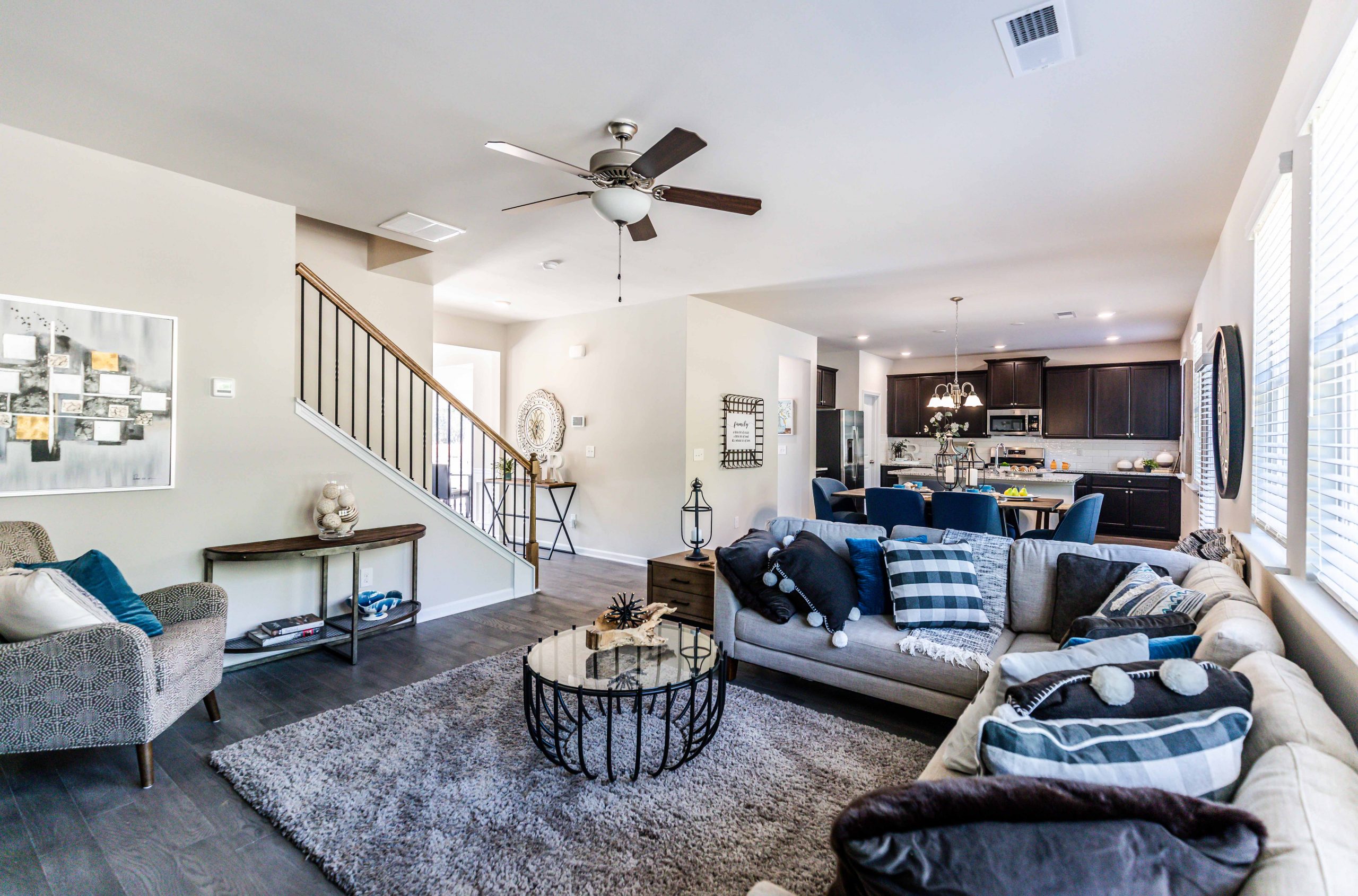





:max_bytes(150000):strip_icc()/orestudios_lonemadrone_05-0294eeaf854c4d8ebf34d13990996973.jpg)







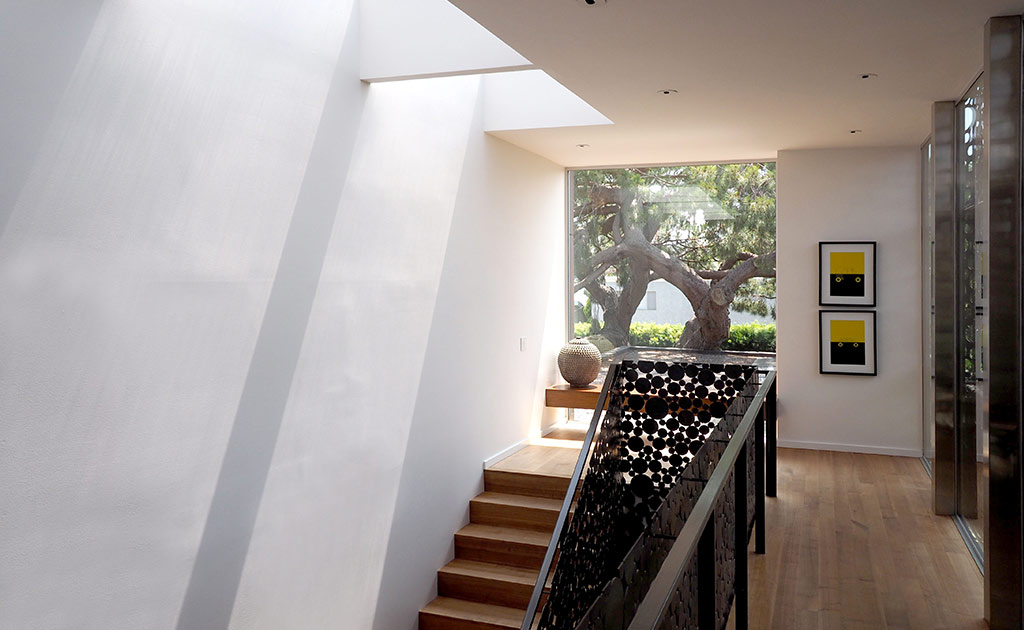
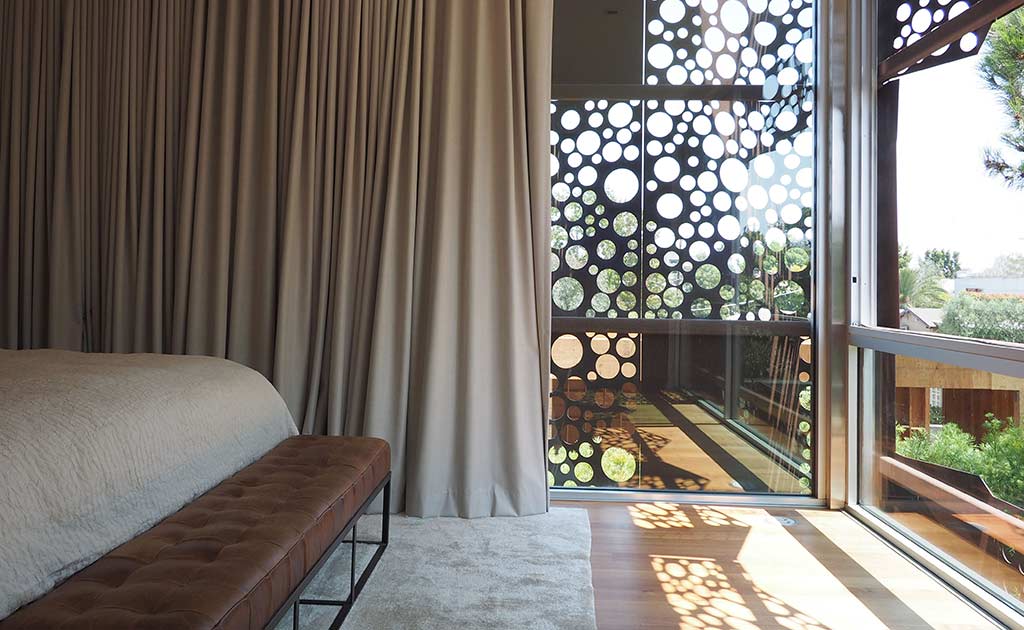

















/3c57467624397db54167f36ca4eece0f-586730ef3df78ce2c31c9fd6.jpg)
